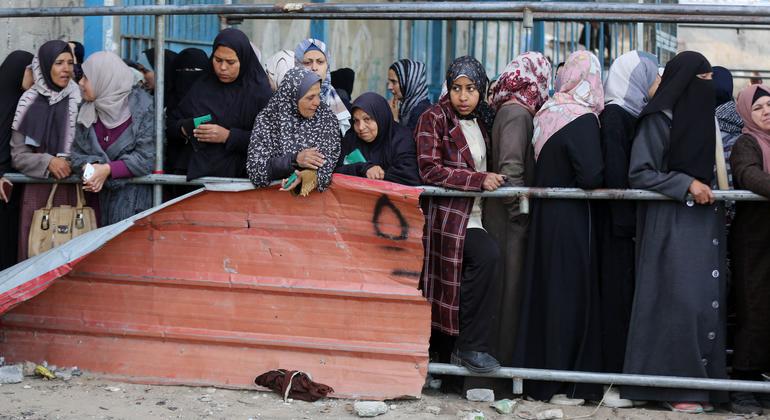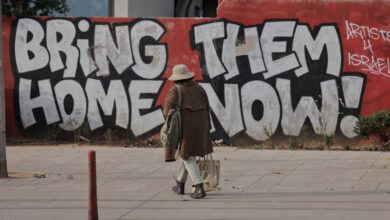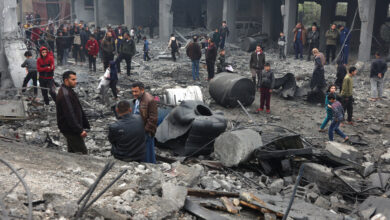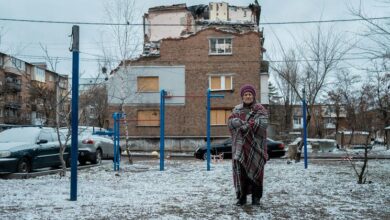‘Enough of death and destruction’: Gazans hope for ceasefire and a better future

About 90% of the population across the Gaza Strip has had to leave their homes, forced to relocate to avoid Israeli military operations. Many people have had to relocate multiple times, about 10 times or more.
Much of Gaza is in ruins, while Israeli airstrikes and military operations have damaged or destroyed about 60% of buildings, including homes, schools and hospitals. The relentless bombing campaign pushed the health sector to the brink, the solid waste disposal system collapsed, causing serious environmental and health risks, and the water system was severely curtailed.
UN news Correspondents in Gaza spoke to displaced civilians sheltering in Nuseirat, central Gaza, who are hoping to return to what’s left of their homes and rebuild their lives.
Despite dire humanitarian conditions, um Mohammed Hanoun was determined to return to the Al-Karama neighborhood in northern Gaza with her family, even though she received news that her house had been destroyed in an attack. drone fair.

Um Mohamed Hanoun, who was displaced from the Al-Karama neighborhood in Gaza City to the central Gaza area.
“My plan was to clear the rubble, pitch a tent on my land, and live thereshe said. “All I care about is seeing my house. I hope that Gaza will be rebuilt as it was and that our lives will return to the way they were.”
‘We deserve a better life than this’
Sami Abu Tahoun, a child displaced from Gaza City, spoke after receiving news of the ceasefire agreement – which on Thursday was still in doubt. Israel’s war cabinet did not vote on the deal.

Sami Abu Tahoun, evacuee from Gaza City.
The boy said he had not seen his father since the conflict forced them to leave Gaza City, in the northern Gaza Strip. “When we left home, I lost something essential in life, father. When my mother told me to pray, I refused. I want to wait until I can pray to my father.”

Ayman Abu Ridhwan, evacuee from Gaza City to central Gaza Strip.
‘Enough of death and destruction’
“Now we want to think about our future,” said Ayman Abu Radwan, a Palestinian man who, like Sami, had to leave his home in Gaza City for central Gaza to live in a tattered tent. . Enough death and destruction.”
“We are tired. We have endured the intense heat of summer and the cold of winter. Children are dying. Every night, I was awakened by the cry of a two-week-old baby shivering from the cold. I hope that our conditions will improve. We deserve a better life than this.”
According to Mohammed al-Quqa, who was displaced from the al-Shati refugee camp west of Gaza City, even if the cessation of hostilities allows Gazans to return home and for the Strip to be rebuilt, the pain is profound. God will continue.
“The greatest suffering will be the psychological situation. The war has dragged on and our family, our children, have witnessed things they should never have seen.”

A man carries food aid distributed by the United Nations in Gaza.
United Nations humanitarian organizations are ready to provide emergency aid
If the ceasefire takes effect on Sunday, many predict that aid to the Gaza Strip will increase significantly – in line with the reported terms of the agreement.
Throughout the conflict, humanitarian convoys carrying desperately needed aid were repeatedly delayed or denied entry to Israeli military checkpoints (in December, 70% of aid missions Coordination support has been refused).
On Thursday, the World Food Program (WFP) announced that it had 80,000 tons of food waiting outside Gaza or on its wayenough to feed more than a million people.
However, the UN agency also emphasized the importance of humanitarian teams and supplies moving without restriction to reach those in need.
UNRWA focuses on essential health care
The health care system in Gaza has been destroyed by persistent Israeli bombing and more than 12,000 people are awaiting medical evacuation.
On Wednesday, the World Health Organization (WHO) and partners succeeded in evacuating 12 patients to hospitals in Europe, but the agency is calling for more countries to receive specialized treatment once the ceasefire takes effect.
Aid workers have been operating in dangerous conditions: nearly 900 people are believed to have died since October 2023, including 265 workers from the UN refugee agency for Palestinian refugees , UNRWA.
Despite the risks, more than 1,000 UNRWA staff – the majority of whom are local staff – continue to operate health centres, temporary clinics and health posts across Gaza, providing more than 16,000 consultations health every day.




